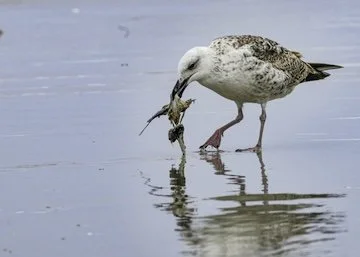On the Beach
Today’s outing was along the beachfront in New Smyrna Beach, Florida. We drove along a 5 mile stretch of the Atlantic coast in search of gulls, waders, shorebirds, and terns. Certain areas of the beach are pretty heavily populated by human rather than avian wildlife, but once you’re past the tourist areas, the crowd thins out and the birds are once again the dominant form of fauna. The “King of the Hill” today was the Herring gull. Outmatched on the food pyramid by only the Greater black-backed gull among species found along the sandy shore, the Herring gull feeds on virtually anything that can possibly be ingested….fish, crustaceans. mollusks, small birds, worms, and is not above feeding on carrion when available.
Among gulls, the only one that the Herring gull comes in second to is the Great black-backed gull. The image above is of in immature bird which is still larger than any of the other gulls on the beach. The Great black-back is “huge” and in juvenile plumage seen above is very pale on the head and breast. After two years, the checkered pattern on the back will become all black. This bird is fairly common in the winter months, but as spring arrives, these birds will all be heading north and will pose a threat to other shore birds nesting on the beaches from the Carolinas all the way up to northern Canada.
The rarest of the gulls we found today would be the Bonaparte’s gull. Bonaparte's gull (Chroicocephalus philadelphia) is a small, elegant seabird known for its distinctive black cap during the breeding season and its striking white underparts. This species is primarily found in North America, especially around inland lakes and rivers, where it forages for insects and small fish. In winter, Bonaparte's gulls migrate to the coastal areas where we found it today. In winter, it displays a more muted plumage characterized by a pale gray back and a soft white body and a distinctive black blotchy ear spot. Their light, buoyant flight and graceful gliding patterns make them a common sight in both freshwater and marine environments, where they often form loose flocks. Conservation efforts have helped stabilize their populations, though habitat degradation remains a concern.
When birding along the shore, you can be relatively sure that you will find gulls of various species. Always a joy and sometimes a challenge to be able to identify the differences between the species.


